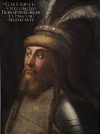A Bon Droit: A Visconti Story
«Il sole e l’azur fino / che tengon in sua brancha / quella uccelletta bianca / qual “A bon droyt” in dolce becco tene / che la sentenza mia tutta contiene».
The Sun and the fine blue [sky] who hold within that gleeful white bird who holds in her beak "A bon droyt", which is what this verse holds too.
This was the ensign for Gian Galeazzo Visconti, which the poet Francesco Vannozzo attributed to none other than Petrarch himself, who visited his dreams and suggested it with celestial voice. "A bon droit" is French for
Rightfully, or
With Good Reason. It was the motto Visconti chose for his quest, as he truly believed him and his house were long destined to rule Italy from shore to shore: from the beautiful banks of the Tyrrenic sea, where Genoa, queen of the Mediterranean, sat glorious and unconquered, to the mighty mountains in the Alps, aegis of the Italians, tall defenders of the peninsula, and to the heel of the peninsula, the great maritime charters of the Southern Mediterranean, where adventures larger than life took place, where many times the cross had traversed the seas to liberate Jerusalem and many times, for lack of leadership, it was broken by the crescent. All that, Gian Galeazzo Visconti considered rightfully his: and overseeing three seas, the granary of the Mare Nostrum, the ultimate prize of many conquerors, the melting pot of civilizations, there stood Sicily, the world's fairest island.
In truth, the opportunity to take Sicily came almost by surprise. Gian Galeazzo's wife, Isabeau, had died giving birth to his son Carlo, who'd unfortunately also passed. All he had left of the marriage were two surviving children, Azzone and Valentina, fragile ownership of

a county, somewhere in France, which he never had a chance to visit, and an alliance with France tenuous at best. Two years afterwards, the tumultuous war between his father, Galeazzo II, and the Papacy, not to mention an Italy's worth of perpetrators who'd banded together to protect Otto of Brunswick, prince-consort of Naples, finally came to an inconclusive end. Gian Galeazzo had lead the Viscontean armies, as his father had become far too sick to participate in the battlements. Galeazzo II died in August of 1378, of natural causes, leaving behind a troubled state and a short-sighted brother, Bernabò, to rule it all. Gian Galeazzo was already emancipated from his father's rule, as he'd received an early portion of the inheritance years prior. Still, the situation posed him as vulnerable, under his cruel uncle's thumb and at the forefront of Italian politics. The new signore was well-aware that one wrong move and all of Italy would be up in arms after him.
Then, out of seemingly nowhere, in the early days of December 1378, a herald found its way to Pavia, offering to Gian Galeazzo the fair hand of Maria d'Aragona, queen of Trinacria.

To the Sicilian court, this was an obvious step. An year prior Maria's father Federico IV, the former king, had already tried finding an ally in the Visconti state by marrying Antonia, daughter of Bernabò, but he'd died later in the same year. Dispositions had been made in 1372 specifically for Maria's accession to the throne of Trinacria - the laws stipulated by Federico III prevented any woman from inheriting the kingdom. Nevertheless, Joan I of Naples and Federico IV had agreed in 1372 to a treaty stipulated exceptionally for Maria. The teenaged queen had been placed under the tutoring and regency of Artale I Alagona, general vicar and 'gran giustiziere' of the kingdom. The nobleman kept her under close watch, in the Ursine Castle of Catania, in company of many maids, servants and the mayor of the palace, Pietro Rizzari, a man in which Alagona confided. With the Kingdom of Trinacria, came the association with the duchies of Athens and Neopatria, in Greece - crusader states in the mountainous region of Attica, once cradle of culture and philosophy. The islands of Malta and Gozo had been scorporated previously, and were inherited by Guglielmo, the bastard child of Federico IV.
Artale Alagona had many exponents of the nobility join him in the regency, including among them three of the noblest men in the country - admiral Manfredi Chiaramonte, Guglielmo Peralta and Francesco Ventimiglia. The four received the Pope's blessing and the title of vicar, and for a few months all was well, until in December Artale decided to overpower his co-regents by finding an ally once again in the Visconti state. His ambassadors reached the Viscontean twin courts, offering an alliance to Bernabò in Milan and a marriage to Gian Galeazzo in Pavia. The young Visconti prince, who'd recently turned 27, represented in Alagona's eyes a perfect scarecrow to keep the rest of the nobility in check and, most importantly, to prevent the Aragonese influence and the growing faction of the 'Catalans' who aimed to unify Sicily and Aragon from enroaching into the island and marking the beginning of the end for Trinacria's autonomy.
Bernabò Visconti, signore of Milan, wasn't a man of vision. He lacked in ambition and political prowess, including the basic skills needed to keep an unruly population of terrified nobles in check by the time succession came about. Meanwhile, all Pope Urban VI cared about for the moment was for Sicily to obtain a male ruler - even if that male ruler's last name was Visconti. Behind the scenes, keeping Trinacria just out of Aragon's reach was a way to maintain them under check, especially with the war in Sardinia looking to be in Arborea's favor. On the other hand, Peter the Ceremonious, king of Aragon, wasn't worried. He had men on the island that could swiftly deal with any attempt to bring Sicily into the Italian fold and out of his, for he was prepared to do anything to keep his hands on the granary of the Mediterranean. These three powerful men exchanged diplomats, nodded to each other and gave unanimously their blessing for Gian Galeazzo's new marriage, each prepared to stab the other in the back and every one of them convinced the situation was now inequivocably in their favor.
Gian Galeazzo Visconti sent his own ambassadors south, informing Artale of his 'overjoyed response' to the marriage proposal and that he'd given dispositions for them to arrange the details of the betrothal. What he did not add was that he would depart as well, eager to make an impression on the queen and his new subjects. Few know the true reason why the Count of Virtue left the port of Genoa, hidden in the planking of a small carrack headed for Messina; some suspect that he truly intended to briefly court the queen before the marriage. Malignant sources, especially from the Catalan faction, claimed Visconti's intent was that of kidnapping the queen and obtaining a significant leverage over Alagona, while benevolent sources depicted Gian Galeazzo enamored with the portraits of the queen and simply craving to see her. What's certain is that after the ship left Messina and continued on its journey south, around Sicily and back north to Genoa, Gian Galeazzo hijacked it halfway to Catania and forced them to unload him in proximity of the port-city, from where he made his way to the Ursine Castle.

The beautiful Ursine Castle, today hosting a venue of the Museo Nazionale Siciliano, is built on a square base, with four towers at the corners and three breaking the pace of the external walls. Inside, past the large gates, Gian Galeazzo is said to have sneaked in, on the night of January 23rd of 1379, presumably nosing around for a grand entrance the following day, and finding a crime at play. Two hooded men, in the dead of the night, were carrying an unconscious girl outside of the castle - the girl was Maria, Visconti recognized her from the portraist he'd been sent. It was then or never; after quickly analyzing the situation, Visconti unsheathed a dagger assailed the sinister figures from the shadows, maiming the first and routing out the second one. The scream of the wounded fiend woke up the castle, and immediately servants started pouring out of all exits, wondering what had happened, who had been attacked and why. Then out of the castle came Rizzari, who pushed Visconti out of the way and unmasked the would-be kidnapper, instantly recognizing him as count Guillermo Raymondo Moncada, a well-known Aragonese sympathizer. Rizzari had him apprehended and locked into a dungeon, before thanking the chivalrous stranger and asking for his name. Gian Galeazzo revealed himself, uncharacteristically humble, and showed himself preoccupied for the queen's health, winning the sympathy of the castle's servants who recognized in him the knights and paladins deeply rooted in Sicilian tradition, but behind that façade the Count of Virtue was thrilled: luck, it seemed, was on his side in the quest for Italian domination.
The glorious destiny of the Visconti house is depicted clearly in glamourised interpretation of the story, freely adapted from the
Historia Siculorum, written between 1390 and 1411 by Siconolfo Lombardi, employed by queen Maria and Gian Galeazzo as their court historian; Lombardi places the prevented kidnapping and the marriage between the two, which took place in May of 1379, at the end of his book, as to sign a passage between one historical period of Sicily and another. Moncada, who to have his life spared revealed the names of his conspirators, died in captivity some time after 1384 - we know this because of the attempt to free him during that year; his fate mirrored that of many members of the Catalan aristocracy who, over the few months following the kidnapping and preceding the marriage, attempted to revolt against Visconti and, when defeated, were captured and often killed. The
Historia, which wants Visconti a glorious conqueror more than anything else, contrasts with what we know from local sources, which depict a much more tolerant Visconti and associates the decrease in support for the Catalan cause, at least in the lower echelons of Trinacrian aristocracy and among the common folk, not to a brutal repression but instead to the colossal failure of the kidnapping and the consequent abandonment of the Aragonophile ideology.
Among those who were unhappy about the marriage and the whole ordeal, two were most prominent; Otto of Brunswick, who'd advocated for Maria's marriage to his ward the young marquis Giovanni III of Montferrat and now saw that way into Sicily blocked, short of killing Gian Galeazzo, and the shocked king Peter of Aragon, who most sources attribute the order for the kidnapping came from, who now had to deal with his tentacles in the island compromise and a new, ambitious prince by Maria's side to worry about. Meanwhile, Pope Urban was pleased with the turn of events - Visconti was now, in his eyes, an useful pawn away from his direct proximity and meddling with a sphere of influence he was more than glad to see curbed. If Aragon got Sicily, Urban thought, Naples would be next, and then possibly Rome. While he would've liked a less rowdy and more easily swayable candidate, such as his nephew Francesco Prignano, to sit beside Maria on the throne of Sicily, he also thought that if the situation required it Visconti could be disloged just as easily as he'd been instated.
What the prince-consort thought of the idea, he didn't know. His children were vulnerable and overseas, his new wife was tangled up to her neck in a deep net of dignitaries it would be difficult to untangle her from and he now had to manage a kingdom plagued with decentralization, guile and deceit. Nevertheless, on the day of his investiture as nominal prince of Syracuse and count of Agosta - formerly Moncada's title, he appeared to his subject a fierce, proud and unshakable man, concealing his great worries and greater ambitions.
The game was on.

